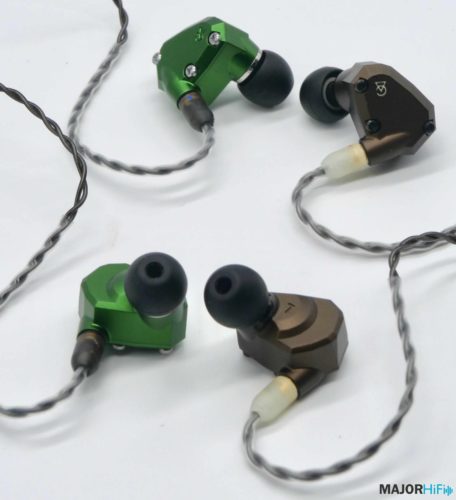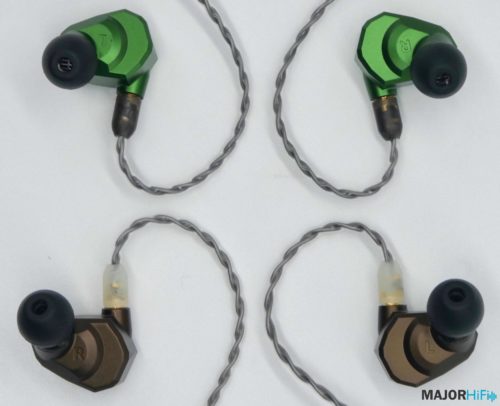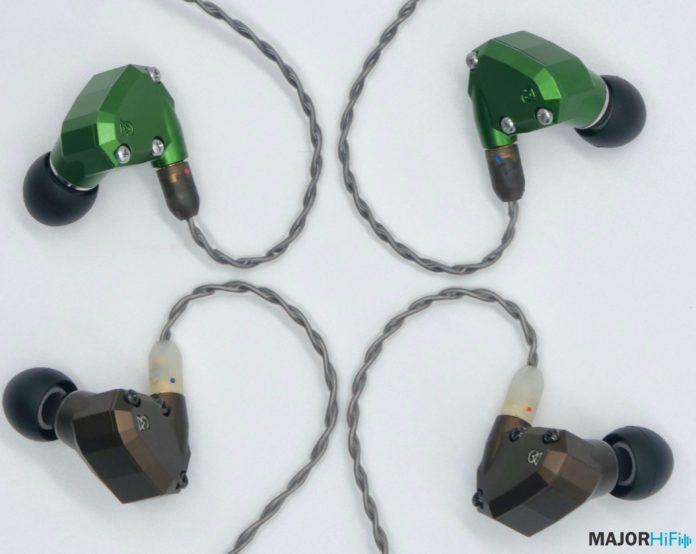Campfire Audio has released a slew of IEMs recently, such as the Satsuma, Honeydew, and Mammoth. However, one IEM in particular, the Holocene, has stirred up some talk. Some have felt it has some major similarities to one of the company’s most popular–but pricey–models, the Andromeda. The Holocene runs for $649, a good few steps down from the Andromeda, which runs for $1,099. Listeners are hopeful they can save some cash and get something close in sound and quality to the Andromeda, which has many excited to get their hands on the Holocene. I’ve got my hands on both of these IEMs at the moment, so I’m here to set the record straight, at least from my perspective.

Looks and Design
These share identical shapes and sizes build wise, the obvious difference being color with the Andromeda’s bright green and the Holcoene’s dark brown. The Holocene also comes with a glow in the dark MMCX cable, which the Andromeda does not.
The Holocene contains 3 balanced armature drivers, one for their high end and two for their mid/low end. The Andromeda, on the other hand, contains 5 balanced armature drivers, using two for the high end, two for the lows, and one for the mids.
Holocene: Frequency response of 5Hz – 20kHz / Impedance of 5.4 Ohms
Andromeda: Frequency response of 10Hz – 28kHz / Impedance of 12.8 Ohms

Soundstage
These do have similar soundstages on many fronts. I personally don’t find a vast difference between the soundstages on most Campfire IEMs, they all tend to hit the spot for me. But some do reign superior of course, and the Andromeda has always taken the cake for me. Compared to the Holocene, the Andromeda casts small details and textures a bit further out. The Andromeda seems to have more expert separation than the Holocene, too. This being said, the Holocene comes closer to the Andromeda’s imaging abilities than one might expect. While it can’t achieve quite the same level of clarity and seamless layering, it still has a lot of air and a very holographic feel.
Lows
My First thought when comparing the low end of these was that they often sound like they’re playing the same drum but with different sticks. Perhaps that sounds vague, let me expand. The Andromeda and Holocene have a similar low end timbre, but the Andromeda has a stronger attack and a more noticeable sub response. The Holocene’s low end is less intensely defined and separated from the rest of the mix, having a bit more blend into the whole of the composition. The Andromeda is definitely the bassier of the two, but not by an extremely wide margin. The Holocene focuses its low end on the upper lows a bit more than the Andromeda, which smooths this area out in favor of warming up the mix with a reasonable dose of sub frequencies.
Mids
The Holocene has a sharper high mid than the Andromeda; this was my immediate takeaway. The Andromeda has a more groomed, controlled mid range that feels a bit more purified and fine-tuned overall. The Holocene doesn’t feel muddy or disorganized, but perhaps slightly less refined than the Andromeda. Similar to the lows, they do share a similar timbre in the mid range. The Andromeda has a more saturated, rounded mid response, but does have a similar high mid boost, just not pushed as far as the Holocene. The Andromeda also brings up the low mids a bit more to balance things out and increase warmth, while the Holocene leaves the low mid a bit more neutral.
Highs
After having heard both of these IEMs on their own, I was expecting the Andromeda to be the brighter of the two. It’s always been one of the brightest Campfire IEMs to my ears. Surprisingly, however, the Holocene is definitely a good few notches brighter than the Andromeda. Paired with its more pointed high mid, this gives the Holocene a bit of a crisper sound than the Andromeda, though also makes it less warm. This being said, the Holocene still seems to retain the smooth, snappy character of the Andromeda, but with a more sparkling, arguably cutting edge. The high end is definitely what differentiates these most intensely.

Overall
The buzz that the Holocene is a “poor man’s Andromeda” has some definite truth to it, but is far from the fully story. Don’t fool yourself into thinking buying the Holocene will simply get you a slightly downgraded Andromeda. I wouldn’t personally call the Holocene a cheaper Andromeda, just a cheaper option that is reminiscent of the Andromeda in some respects.
These both have different goals and characters despite their similarities. The Andromeda aims for a more bass heavy, warm, and cinematic sound, while the Holocene goes for a notably brighter, crisper feel with more understated lows. These do feel closely related in their performance and timbre, but at the end of the day the Andromeda’s higher price point still make sense to me. In my opinion, it has a more realistic, all-encompassing sound than the Holocene is able to master. Regardless, whether the Holocene feels like a steal to you or a “you get what you pay for” scenario is going to be case by case.
You can purchase the Campfire Audio Holocene and Andromeda at Audio46
MAJORHIFI may receive commissions from retail offers.








